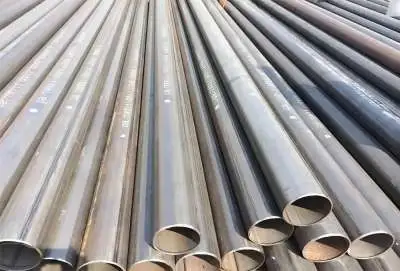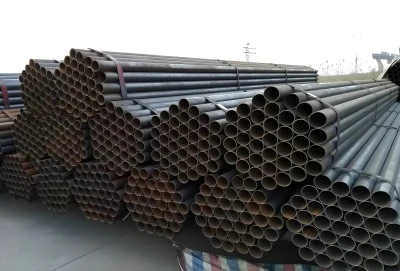High Frequency Welded pipe (HFW pipe) and Electric Resistance Welded (ERW) pipe are terms often used interchangeably in the steel pipe industry. While they share many similarities, some nuances in their manufacturing processes and characteristics are worth exploring. This article will delve into the key aspects of HFW and ERW pipes, examining their welding processes, heat generation methods, weld quality, and relevant standards and specifications.
|
|
|
Welding Process:
The welding processes for HFW and ERW pipes are fundamentally similar but with some distinct differences. Both methods involve forming a flat steel strip into a cylindrical shape and welding the seam where the edges meet. However, the frequency of the electrical current used in the welding process is what sets them apart.
ERW pipes typically use low-frequency alternating current (AC) for welding, generally in the range of 50-500 Hz. This method has been in use for many decades and is still widely employed in pipe manufacturing. The low-frequency current is applied to the pipe edges through contact electrodes, generating heat through electrical resistance.
HFW pipes, on the other hand, use high frequency welded pipe, usually in the range of 100-500 kHz. This high frequency current is induced in the pipe edges using an induction coil, rather than direct contact electrodes. The higher frequency allows for more precise control of the heating process and results in a narrower heat-affected zone.
While both processes achieve the same result - a welded steel pipe - the HFW method is generally considered more advanced and efficient. The high-frequency welding allows for faster production speeds and better control over the welding parameters, which can lead to improved weld quality.
Heat Generation:
The method of heat generation is a key differentiator between HFW and traditional ERW pipes. In ERW pipes, heat is generated through electrical resistance as current flows through the steel. This resistance heating occurs throughout the thickness of the pipe wall at the weld point.
HFW pipe, however, utilizes the skin effect and proximity effect associated with high frequency currents. The skin effect causes the current to flow primarily near the surface of the conductor, while the proximity effect concentrates the current at the edges of the steel strip. These effects result in more localized heating at the exact point where the weld is to be formed.
The localized heating in HFW pipes offers several advantages. It allows for more efficient use of energy, as heat is concentrated precisely where it's needed. It also results in a narrower heat-affected zone, which can lead to better mechanical properties in the welded area. Additionally, the high frequency allows for very rapid heating, enabling faster production speeds compared to traditional ERW methods.
Weld Quality:
Both HFW and ERW processes can produce high-quality welds when properly controlled. However, the HFW process offers some potential advantages in terms of weld quality.
The narrower heat-affected zone in high frequency welded pipe means that a smaller portion of the pipe's material is altered by the welding process. This can result in more consistent mechanical properties across the pipe, including at the weld seam. The precise control offered by high frequency welding also allows for better management of the welding parameters, potentially reducing the likelihood of weld defects.
HFW pipes often exhibit excellent uniformity in wall thickness and diameter, thanks to the precise control possible with high frequency welding. This dimensional accuracy can be particularly important in applications requiring tight tolerances.
It's worth noting that the quality of the weld in both HFW and ERW pipes is heavily dependent on proper process control and quality management. Factors such as the quality of the input material, the accuracy of the forming process, and the consistency of the welding parameters all play crucial roles in determining the final weld quality.
Standards and Specifications:
In terms of industry standards and specifications, HFW and ERW pipes are often treated similarly. Many standards that historically referred to ERW pipes now include HFW pipes under the same umbrella. For example, the American Petroleum Institute's API 5L specification for line pipe covers both ERW and HFW pipes.
Some key standards and specifications that cover both ERW and HFW pipes include:
l API 5L: Specification for Line Pipe
l ASTM A53: Standard Specification for Pipe, Steel, Black and Hot-Dipped, Zinc-Coated, Welded, and Seamless
l ASTM A500: Standard Specification for Cold-Formed Welded and Seamless Carbon Steel Structural Tubing in Rounds and Shapes
l EN 10217-1: Welded steel tubes for pressure purposes Technical delivery conditions
These standards typically specify requirements for chemical composition, mechanical properties, dimensions, and testing procedures, regardless of whether the pipe is manufactured using ERW or HFW processes. However, some specifications may include additional requirements or considerations for HFW pipes, particularly in terms of the frequency range used in welding.
China High Frequency Welded Pipe:
Chinese HFW pipe is used in a wide range of applications, from oil and gas pipelines to structural supports in construction. LONGMA GROUP can produce pipes to various international standards, including API, ASTM, and EN specifications. If you are choosing your manufacturers, welcome to contact us at info@longma-group.com.














